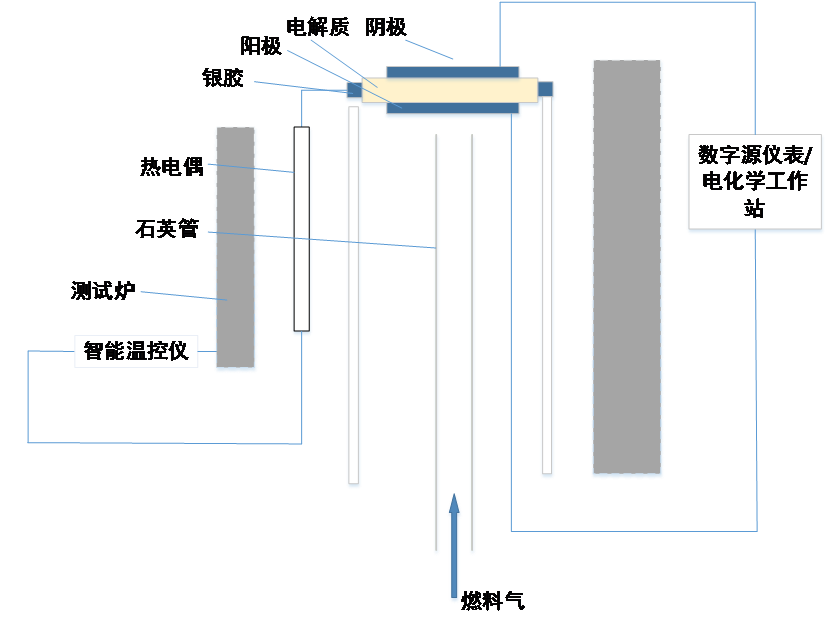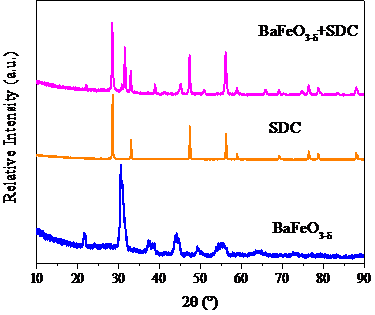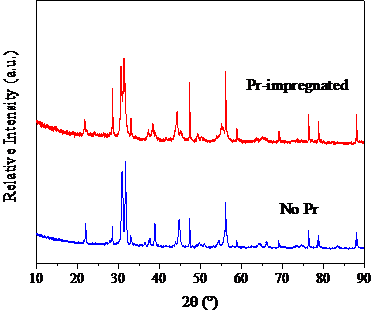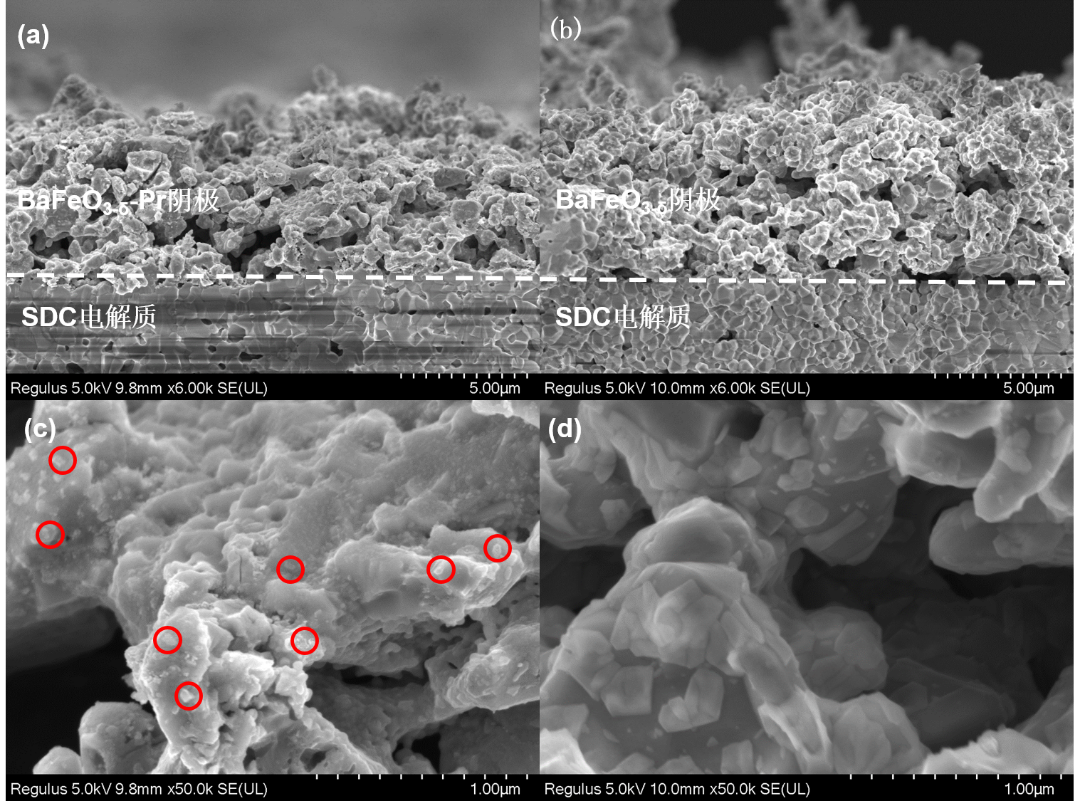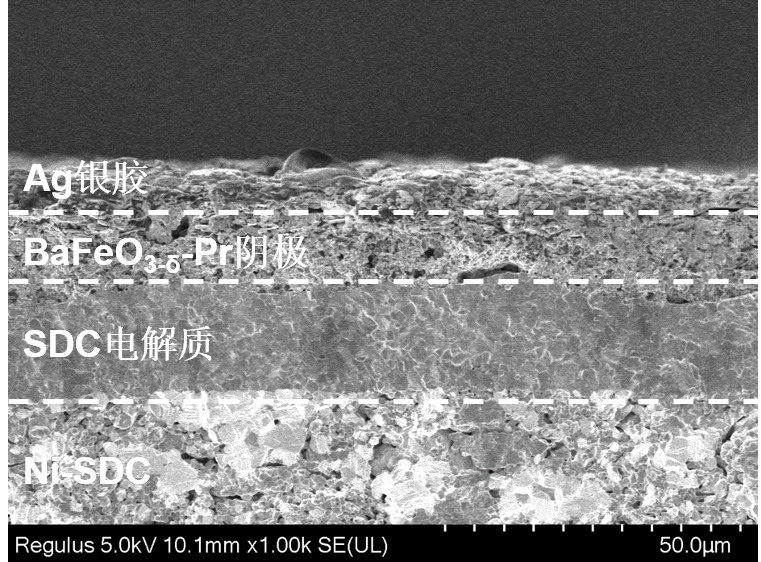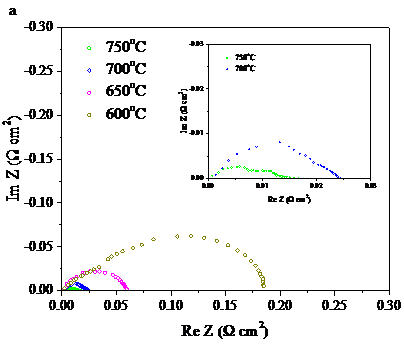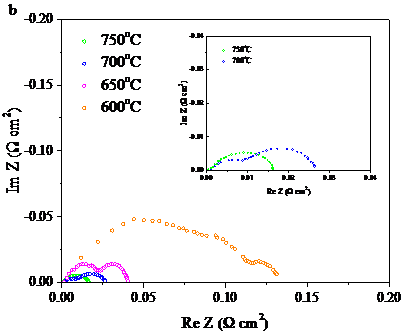Pr修饰BaFeO3-δ作为固体氧化物燃料电池阴极材料的电化学性能研究毕业论文
2020-04-22 19:37:16
摘 要
固体氧化物燃料电池(SOFC)传统上在1000 °C下运行,并且在各种类型的燃料电池中效率最高,将SOFC的操作温度降至中温或低温将显著提高其耐久性和热相容性。阴极氧化还原反应(ORR)具备较高活化能,这解释了SOFC的总电阻主要是由阴极极化所引起的,特别是在低温状况下。因此,开发Fe基钙钛矿氧化物作为替代阴极材料具有重要意义
本论文选择具有各种晶体结构的钙钛矿氧化物BaFeO3-δ (BF)作为阴极材料,BaFeO3-δ对氧还原反应具有高催化活性。为了改善SOFC中低温下阴极极化阻抗,本论文选择用氧化镨(PrOx)修饰BF阴极(BF-Pr)。实验中选择浸渍的方法,将硝酸Pr浸渍到BaFeO3-δ阴极骨架中。扫描电子显微镜显示BF阴极骨架中存在PrOx颗粒。在650 °C时,BF-Pr对称电池阻抗为0.043 Ω cm2,未浸渍的BF对称电池阻抗为0.056 Ω cm2,浸渍前后对比结果为阻抗下降了23%;以BF粉体为阴极的单电池在650、600、550、500、450 °C下的功率密度峰值分别为950、602、392、203、95 mW cm-2;以BF -Pr为阴极的单电池在相同的温度点下其功率密度峰值分别为1071、845、481、239、97 mW cm-2,600 °C时浸渍后的电池性能提升了40%左右。因此,用PrOx修饰的BaFeO3-δ阴极是一种具有应用前景的阴极材料。
关键词:固体氧化物燃料电池 中低温 阴极材料 氧化镨浸渍 BaFeO3-δ
Study on Electrochemical Properties of Pr Modified BaFeO3-δ as Cathode Material for Solid Oxide Fuel Cells
Abstract
Solid oxide fuel cells (SOFCs) have traditionally operated at 1000 °C and are the most efficient in all types of fuel cells. Lowering the operating temperature of SOFCs to medium or low temperatures will significantly improve their durability and thermal compatibility.. The cathodic redox reaction (ORR) has a higher activation energy, which explains that the total resistance of the SOFC is mainly caused by cathodic polarization, especially at low temperatures. Therefore, the development of Fe-based perovskite oxides as an alternative cathode material is of great significance.
In this paper, BaFeO3-δ, (BF) a perovskite oxide with various crystal structures, was selected as the cathode material, and BaFeO3-δ has high catalytic activity for oxygen reduction. In order to improve the sharp increase of cathodic polarization resistance at low temperature in SOFC, this paper chooses to modify the cathode with praseodymium oxide (PrOx). In this experiment, the method of impregnation was selected in this paper, and Pr was impregnated into the cathode skeleton. Scanning electron microscopy (SEM) images show the presence of PrOx particles in the BaFeO3-δ cathode framework. The symmetrical battery’s impedance impregnated with cerium nitrate solution at 650 °C is 0.043 Ω cm2, the impedance of the unimpregnated symmetrical battery is 0.056 Ω cm2, and the impedance is reduced by 23% before and after immersion; The peak power density of the single-cell with BF powder as cathode at 650, 600, 550, 500 and 450 °C is 950, 602, 392, 203, 95 mW•cm-2, respectively;The peak power density of cell with BF-Pr powder as cathode at the same temperature point are 1071, 845, 481, 239, 97 mW•cm-2, respectively, and the performance of the battery after immersion is increased by about 40% at 600 °C. Therefore, the BFcathode impregnated with PrOx is a cathode material that has a promising future and is expected to be put into use.
Keywords: Solid oxide fuel cell medium and low temperature cathode material PrOx-impregnated BaFeO3-δ
目录
摘要 I
Abstract II
第一章 绪论 1
1.1 前言 1
1.2 固体氧化物燃料电池(SOFC) 2
1.2.1 固体氧化物燃料电池特点 2
1.2.2 固体氧化物燃料电池的工作原理 3
1.2.3 固体氧化物燃料电池的组件 4
1.2.4 阴极材料 5
1.3 本论文的研究目的和工作内容 7
1.3.1 本论文的研究目的 7
1.3.2 本论文的工作内容 8
第二章 实验部分 10
2.1 实验试剂和仪器 10
2.2 电解质粉体及阴极粉体、浆料的制备 11
2.2.1 溶胶凝胶法制备电解质和阴极粉体 11
2.2.2 BaFeO3-δ浆料的制备 12
2.3 电池的制备 13
2.3.1 对称电池的制备 13
2.3.2 单电池的制备 13
2.4 BaFeO3-δ阴极纳米修饰 14
2.5表征方法 14
2.5.1 X射线衍射(XRD) 14
2.5.2 扫描电子显微镜(SEM) 14
2.6 电化学性能测试 14
2.6.1电化学阻抗谱(EIS) 14
2.6.2 单电池性能 15
第三章 结果与讨论 17
3.1 XRD表征 17
3.1.1 BaFeO3-δ阴极粉体表征 17
3.1.2 电池阴极结构表征 18
3.2 SEM表征 18
3.3电化学阻抗谱 20
3.4 对称电池稳定性测试 22
3.5 单电池性能测试 23
第四章 结论与展望 27
4.1 结论 27
4.2 展望 27
参考文献 27
致谢 31
绪论
前言
能源是人类科技进步的不可或缺的物质支撑。中国各方面的稳定高效前进,脱离不了丰富的能源支持。如今,煤、石油等传统能源是当前社会的主要能源。然而,化石能源除了提供能源这个主要作用外,还将造成环境污染和温室气体排放,特别是有毒气体,如二氧化碳和一氧化碳,会对城市地区造成健康危害。本地和全球都包括污染空气和危险的不可治疗病毒对健康和环境造成的危害。传统的能源转换技术,如使用煤,石油和天然气等化石燃料的发电厂,是酸雨,全球气候变化,平流层臭氧消耗,洪水等的主要来源。这些传统的能量转换技术不断增加全球变暖和健康问题[2, 3]。因此,寻找安全、高效的清洁能源已经迫在眉睫。
大多数能量转换装置都在消耗化石燃料,而燃料电池拥有可以避免产生温室气体的先进技术。易于安装和操作使燃料电池成为一种有前景的清洁、高效和经济的能量转换装置。在工业上,燃料电池作为电化学装置以取代传统的化石燃料驱动的能量转换技术朝向燃料电池操作的能量转换技术,已引起相当大的关注。
如今,燃料电池系统的能量转化不受卡诺循环限制,理论能量转化效率可达90%,实际使用效率亦可达40-60%,而火力发电及核电的效率大都在30%至40%[4]。燃料电池根据其工作温度及电解质类型的不同,主要分为五类,即碱性燃料电池(Alkaline fuel cell,AFC)、熔融碳酸盐燃料电池(Molten carbonate fuel cell,MCFC)、磷酸燃料电池(Phosphoric acid fuel cell,PAFC)、质子交换膜燃料电池(Proton exchange membrane fuel cell,PEMFC)和固体氧化物燃料电池(Solid oxide fuel cell,SOFC),表1-1为主要五类燃料电池的特点[5]。
相关图片展示:
